冬の間はいろんな小鳥たちが集団行動をします。カラ類と呼ばれる、シジュウカラやコガラ、ヤマガラ、ヒガラ、そしてそれに混じってエナガ、コゲラなどが小集団を形成し、仲良しかどうかを問わず近い範囲で行動し、お互いの動きをチェックしながら食べ物を探したり、危険を回避したりする姿が見られます。こうした集団形成は「混群(こんぐん)」と呼ばれます。
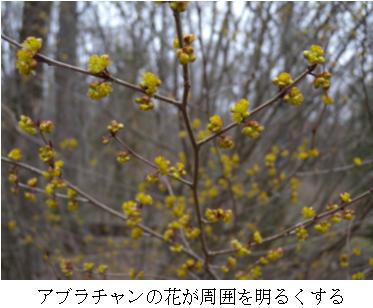
やがてフキノトウを見かける季節となると、こうした混群も解消され、基本的にメスとオスのツガイによる縄張りを主張する行動に移ります。縄張りを声高らかに宣言する美しくよく透る声、これは「さえずり」と呼ばれ、普段の、やる気の無い地鳴きとは違い、気合いの入ったものになります。
ウグイスの「ホーホケキョ」、シジュウカラの「ツツピー」、ゴジュウカラの「フィーフィーフィー」、ヤマガラの「ツンツンピー」など、鳴き方には鳥の種類ごとに特徴があります。
また、場所によっても、個体によっても、よく聞き比べるとその声やリズム、イントネーションに微妙な違い(方言のような?)があり、ほんの数キロほど離れた場所でもシジュウカラのさえずりが少し違って聞こえ、おもしろく感じております。たとえばソフィアート・ガーデンでは「ツツピー」の真ん中の「ツ」が高く、そこから一里ほど離れた離山周辺では「ピー」が高いように聞こえます。両方ともたくさんのシジュウカラがいますが、それぞれの方言を共有しているように聞こえます。
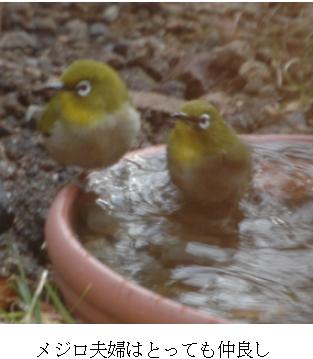
一方、同じカラ類でもヤマガラ、ヒガラ、コガラ、ゴジュウカラは、この二つの場所ではさえずりはほとんど変わりません。シジュウカラの場合は、ヤマガラに比べ行動範囲が狭く、癖として代々継承されやすいのかもしれない、などと想像しております。
また、イカルや夏に渡ってくるキビタキのさえずりも、この二つの場所では違って聞こえます。しかし、これは継続して何羽も、あるいは何代も観察を続けなければ分からないことです。たまたま観察している個体の「癖」に過ぎないのかもしれません。少なくともここ数年の個人的な観察の印象です。
こうしたさえずりの季節は、小鳥たちの結婚式の風景をよく目にします。メスが羽を振るわせて、ヒナのような甘えた声を出すと、オスがメスに食べ物を口渡しします。「求愛給餌(きゅうあいきゅうじ)」という行動です。
まるで、これから生まれてくるたくさんの雛たちへ休む間もなく給餌し続ける自分たちの近未来を演じているかのような行動です。これは、彼ら自身とても楽しいのか、際限なく何度も何度も繰り返されます。
私どもの元へ、いつもの仲良しのヤマガラ(オス)が慌ただしく飛んで来て、「ビービー!」と焦る調子で催促し、手に乗って落花生を受け取ると、まっすぐペアのメスの待つ枝に行き、プレゼントしている姿をよく見ます。大好物の落花生を、自分自身も少しは食べているようですが、すぐにメスがそばに来て羽を振るわせて「ちょうだい!」と彼に要求すると素直にメスにプレゼントします。そして自分はまた私どもの手まで出張します。プロポーズするのもなかなか大変なようです。
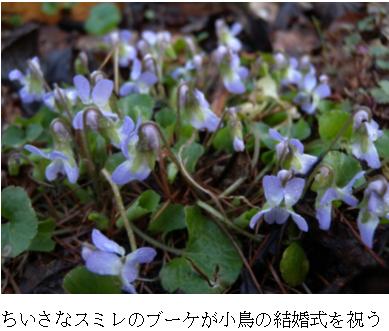
私どものフィーダーは、こうした小鳥の結婚式における格好のプレゼントの探し場所になっているのでしょう。この時期になると、メスは自分で籠のヒマワリをとることを控え、羽を振るわせ、もっぱらオスからもらう場面が繰り広げられます。でも、たまにはメスも素に戻って自分で食べに来たりもしますので、演じるときと普段とのバランスがおもしろく見ていて飽きません。
ところでカワラヒワのツガイは、この結婚式が特別大好きなようで、羽織の内側のあざやかな黄色い羽を輝かせて、なんども求愛給餌しています。メスだけでなくオスもいっしょに羽を振るわせているように見えます。相思相愛って幸せ!と全身全霊で喜んでいます。シジュウカラなどは、義務的な淡々とした感じで求愛給餌しているツガイもいて、種により個体により、結婚の重み(?)や幸せ感が違うようで、これは人間と同じかもしれませんね。
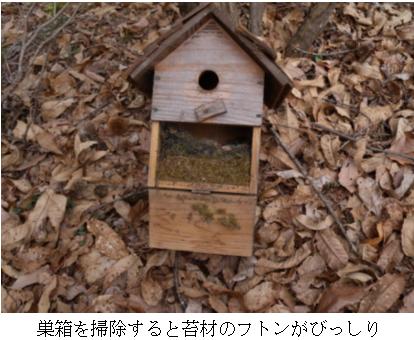
求愛給餌と同時に、新居を探す必死な姿を目にします。巣箱は争奪戦となり、それこそ夫婦でこれは、と思う物件を見つけたら、即入居しないといけません。少し飛び去った隙に、他のツガイに取られてしまいます。
もちろん自然界の木の洞(ウロ)を利用したり、木をくりぬいて巣を作ったり(アカゲラなどのキツツキ)や、自分たちで枝を組み合わせて作ったり(キジバト)、草などを組み合わせて作ったり(メジロやウグイス)、羽毛と蜘蛛の糸で作ったり(エナガ)など、様々です。
巣箱を利用する場合でも、使用後にその中を掃除する際に驚くのは、ほんとうにここまであの小さな体でよく集めたと思うほどの大量の苔を敷き詰め、フカフカの布団にしていることです。コケだけのこともあれば、犬の抜け毛や鳥などの羽毛、やわらかな樹皮や枯れ草など、ありとあらゆる天然素材を見事に生かして、すばらしい巣を作り上げています。
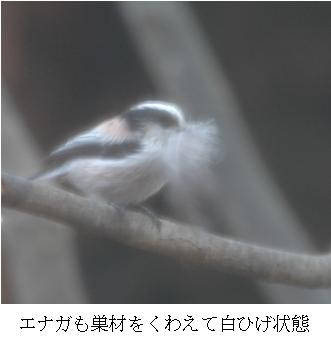
こうした営巣の素材を求めて、これからの時期小鳥たちは必死になり、夢中になりすぎて、普段より無防備に見えます。よく育った苔の多い場所では、苔を口にくわえて剥がしながら、何度も往復する小鳥の姿や、犬小屋に抜け毛を拝借に行く姿を目にします。
おもしろいのが、私どもがバラを誘引するために麻ひもをくくりつけている目の前で、その麻ひもを毟ってほぐし、顔中ひげのようになっている、普段仲良しの小鳥たちの姿です。
こちらはバラを誘引しているつもりでも、彼らにとっては格好の巣材を提供している姿に見えるようで、「待ってました!」とばかりに目の前で麻ひもを毟ってほどいて巣に持って行ってしまいます。まあ、彼らのお役に立てれば私どもとしては嬉しいのですが・・・。
もう、巣作りに夢中になるとまわりが見えなくなるのか、あるいは私どもが彼らの味方であることを知っている安心感からか、麻ひもを手に持って庭仕事のために歩いている私の手の中に、いきなり予期せぬ方向から、小さなヒガラが飛び込んで麻ひもにたかったときは、こちらもかなりびっくりしました。
そのうち、小さな巣箱から、ささやくような、そしてやがては脅迫するような「お腹すいた」コールが、たくさんの雛たちからわき上がり、小鳥の夫婦は寝る間も食べる間もなく、へとへとになるまで虫を雛に届ける姿が見えるようになります。
『 ソフィアート・ガーデン物語 』 第8話 「小鳥の結婚式」
有限会社ソフィアート スタッフM( 竺原 みき )
The Tale of Sophiart Garden
>>To the Previous Story | >>To the Next Story
Chapter 8
“The Little Birds’ Wedding”
April 19, 2012
During winter, you can observe what are called 'tit groups' - including Japanese tits, willow tits, varied tits, coal tits, and mixed in with them, long-tailed tits and Japanese pygmy woodpeckers - forming small groups. Whether they are friendly with each other or not, they move within close proximity, checking each other's movements while searching for food or avoiding danger. This type of group formation is called a 'mixed-species flock' (kon-gun)."
As the season shifts and butterbur sprouts begin to appear, these flocks gradually dissolve. The birds then transition to a new phase, where each pair—male and female—establishes and defends its own territory. Their vocal declarations become stronger and more distinct. This is called “song,” which differs from their usual, more subdued calls. Instead of their everyday, idle chirps, their singing is filled with energy and purpose.
The Japanese bush warbler sings “Hō-hokekyo,” the Japanese tit calls “Tsutsu-pii,” the nuthatch sings “Fee-fee-fee,” and the varied tit’s call is “Tsun-tsun-pii.” Each species has its own unique song.
Interestingly, even within the same species, their songs vary subtly by location and individual. If you listen closely, you can detect differences in rhythm and intonation—almost like regional dialects. For example, at Sophiart Garden, the middle “tsu” in the Japanese tit’s “Tsutsu-pii” is pronounced with a higher pitch, whereas in the nearby Harunoyama area, about a kilometer away, the “pii” is the higher note. Both places have many Japanese tits, yet they seem to share distinct “accents” within their own groups.
On the other hand, other titmice species—such as the varied tit, coal tit, marsh tit, and nuthatch—do not exhibit noticeable differences in song between these two locations. This might be because Japanese tits have a smaller range of movement compared to varied tits, making it easier for their unique song patterns to be passed down through generations.
The same phenomenon can be observed in other birds like the Japanese grosbeak and the narcissus flycatcher, which migrates here in the summer. However, to determine whether these differences are truly characteristic of the species or just individual quirks, long-term observation across multiple individuals and generations would be necessary. At least for the past few years, this has been my personal impression based on my observations.
A Season of Love and Courtship
During this season of singing, we often witness scenes that resemble weddings among the birds. When a female flutters her wings and calls out in a sweet, baby-like voice, the male responds by offering her food. This behavior, known as “courtship feeding,” is a symbolic act of affection.
It almost seems as if they are rehearsing for their near future—when they will be tirelessly feeding their soon-to-hatch chicks. The pairs appear to enjoy this ritual, repeating it over and over again with great enthusiasm.
One of the familiar male varied tits in our garden often rushes over to us, calling frantically, “Bee-bee!” as if demanding something urgently. When he lands on my hand and receives a peanut, he immediately flies straight to a nearby branch where his mate is waiting and presents it to her as a gift. Although he does nibble on the peanut himself, as soon as the female flutters her wings and demands, “Give it to me!” he obediently offers it to her. Then, he promptly returns to us for another peanut. It seems that even in the bird world, making a proposal is quite the effort!
Our bird feeder has become a perfect place for these little wedding gifts. During this season, females refrain from taking sunflower seeds from the feeder themselves, instead choosing to wait and receive them from their mates. However, every now and then, a female momentarily forgets her role in the performance and casually eats on her own. Watching this balance between playing a part and acting naturally is endlessly amusing.
Meanwhile, among greenfinches, courtship feeding is taken to an entirely different level. They seem to adore their “wedding ceremony” more than any other species. They flutter their wings excitedly, revealing the vivid yellow feathers on the undersides of their wings, and engage in courtship feeding repeatedly. Unlike the other birds, both the male and female seem to participate in the wing-fluttering. Their display of pure joy in being together is almost heartwarming—like a couple deeply in love, celebrating their happiness with their whole being.
By contrast, Japanese tits sometimes engage in courtship feeding in a more dutiful, business-like manner. The degree to which different species—or even individual pairs—express the “weight” of marriage and the joy of being together varies. In this regard, perhaps they are not so different from humans.
A Fierce Competition for Nesting Sites
At the same time as these wedding-like rituals, another urgent task takes place—finding a home. The competition for nest boxes is fierce. If a pair finds a promising spot, they must move in immediately. Even the slightest delay can result in another couple taking it right from under them.
Of course, many birds do not rely on nest boxes. Some use natural tree cavities, like woodpeckers that carve their own nests. Others, like turtle doves, build nests by intertwining twigs, while Japanese white-eyes and bush warblers weave grass into their nests. Long-tailed tits construct elaborate nests using feathers and spider silk.
Even when birds use nest boxes, their dedication to making them comfortable is astonishing. When we clean out the used boxes, we often find a thick layer of moss—so much that it’s hard to believe such tiny creatures gathered it all. Sometimes, in addition to moss, they incorporate dog fur, bird feathers, soft bark, or dried grass, creating a wonderfully cozy home using an array of natural materials.
During this nesting period, birds become so focused on collecting materials that they seem more vulnerable than usual. In areas rich with moss, they tirelessly carry beakfuls of it back and forth. Some even visit dog houses to collect fur for their nests.
A particularly amusing scene unfolded in our garden when birds started plucking fibers from the twine we used to train our roses. As I stood there working, they eagerly pulled at the twine, unraveling it into thin strands until their faces were covered in what looked like beards.
It seems that while I believed I was tending to my roses, the birds saw me as a generous provider of top-quality nest materials. They wasted no time in repurposing the twine, as if saying, “We’ve been waiting for this!”
One day, while I was carrying twine in my hand, a tiny coal tit unexpectedly swooped down from an unseen direction and clung to it. Startled, I couldn’t help but laugh at its sheer determination.
Before long, soft murmurs—gradually turning into urgent cries of “We’re hungry!”—will start rising from the tiny nest boxes. The devoted bird parents will soon be working tirelessly, forgoing sleep and food, as they deliver countless insects to their ever-demanding chicks.
The Tale of Sophiart Garden
Chapter 8:“The Little Birds’ Wedding”
Miki Jikuhara, Sophiart Karuizawa






